 W
WWater supply is the provision of water by public utilities, commercial organisations, community endeavors or by individuals, usually via a system of pumps and pipes.
 W
WAn abreuvoir, can mean a basin containing water or a type of masonry joint.
 W
WAn air well or aerial well is a structure or device that collects water by promoting the condensation of moisture from air. Designs for air wells are many and varied, but the simplest designs are completely passive, require no external energy source and have few, if any, moving parts.
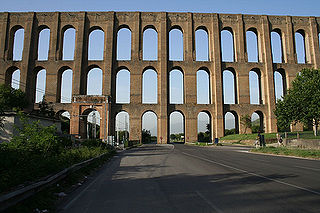 W
WAqueducts or water bridges are bridges constructed to convey watercourses across gaps such as valleys or ravines. The term aqueduct may also be used to refer to the entire watercourse, as well as the bridge. Large navigable aqueducts are used as transport links for boats or ships. Aqueducts must span a crossing at the same level as the watercourses on each end. The word is derived from the Latin aqua ("water") and ducere, therefore meaning "to lead water". A modern version of an aqueduct is a pipeline bridge. They may take the form of tunnels, networks of surface channels and canals, covered clay pipes or monumental bridges.
 W
WAn aqueduct is a watercourse constructed to carry water from a source to a distribution point far away. In modern engineering, the term aqueduct is used for any system of pipes, ditches, canals, tunnels, and other structures used for this purpose. The term aqueduct also often refers specifically to a bridge carrying an artificial watercourse. Aqueducts were used in ancient Greece, ancient Egypt, and ancient Rome. In modern times, the largest aqueducts of all have been built in the United States to supply large cities. The simplest aqueducts are small ditches cut into the earth. Much larger channels may be used in modern aqueducts. Aqueducts sometimes run for some or all of their path through tunnels constructed underground. Modern aqueducts may also use pipelines. Historically, agricultural societies have constructed aqueducts to irrigate crops and supply large cities with drinking water.
 W
WAn aquifer is an underground layer of water-bearing permeable rock, rock fractures or unconsolidated materials. Groundwater can be extracted using a water well. The study of water flow in aquifers and the characterization of aquifers is called hydrogeology. Related terms include aquitard, which is a bed of low permeability along an aquifer, and aquiclude, which is a solid, impermeable area underlying or overlying an aquifer, the pressure of which could create a confined aquifer.
 W
WColored dissolved organic matter (CDOM) is the optically measurable component of dissolved organic matter in water. Also known as chromophoric dissolved organic matter, yellow substance, and gelbstoff, CDOM occurs naturally in aquatic environments and is a complex mixture of many hundreds to thousands of individual, unique organic matter molecules, which are primarily leached from decaying detritus and organic matter. CDOM most strongly absorbs short wavelength light ranging from blue to ultraviolet, whereas pure water absorbs longer wavelength red light. Therefore, water with little or no CDOM, such as the open ocean, appears blue. Waters containing high amounts of CDOM can range from brown, as in many rivers, to yellow and yellow-brown in coastal waters. In general, CDOM concentrations are much higher in fresh waters and estuaries than in the open ocean, though concentrations are highly variable, as is the estimated contribution of CDOM to the total dissolved organic matter pool.
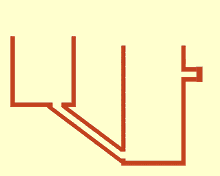 W
WCommunicating vessels is a system of containers filled with a homogeneous fluid, connected at the base and subjected to the same atmospheric pressure. When the liquid settles, it balances out to the same level in all of the containers regardless of their shape and volume. If additional liquid is added to one vessel, a new equal level will be established in all the connected vessels. This process is part of Stevin's Law and occurs because gravity and pressure are constant in each vessel.
 W
WCopenhagen Waterworks opened in 1859 in Copenhagen, Denmark. Located in Studiestræde, between Axeltorv and H. C. Andersens Boulevard, it was Denmark's first waterworks and continued operations until 1951. The complex was designated an Industrial Heritage Site in 2007 and listed in 2010. The former engine house is now home to concert venue Pumpehuset. The other buildings house a daycare.
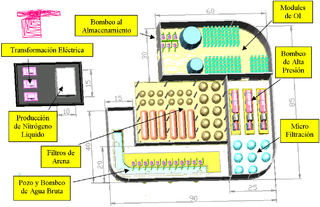 W
WDesalination is a process that takes away mineral components from saline water. More generally, desalination refers to the removal of salts and minerals from a target substance, as in soil desalination, which is an issue for agriculture.
 W
WA detention basin or retarding basin is an excavated area installed on, or adjacent to, tributaries of rivers, streams, lakes or bays to protect against flooding and, in some cases, downstream erosion by storing water for a limited period of time. These basins are also called "dry ponds", "holding ponds" or "dry detention basins" if no permanent pool of water exists. Detention ponds that are designed to permanently retain some volume of water at all times are called retention basins. In its basic form, a detention basin is used to manage water quantity while having a limited effectiveness in protecting water quality, unless it includes a permanent pool feature.
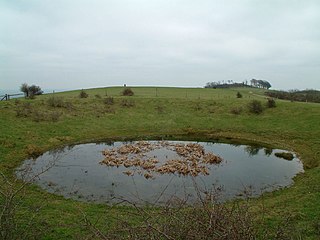 W
WA dew pond is an artificial pond usually sited on the top of a hill, intended for watering livestock. Dew ponds are used in areas where a natural supply of surface water may not be readily available. The name dew pond is first found in the Journal of the Royal Agricultural Society in 1865. Despite the name, their primary source of water is believed to be rainfall rather than dew or mist.
 W
WThe El Paso and Southwestern Railway Water Supply System, in the area south of Nogal, New Mexico, was built in 1908. It was listed on the National Register of Historic Places in 1979.
 W
WThe First Vienna Mountain Spring Pipeline is a major part of Vienna's water supply and was the first source of safe drinking water for that city. The 95 km long line was opened on 24 October 1873, after four years of construction. Today, it delivers 62 million cubic meters of water per year. The water comes from high springs in the Rax and Schneeberg areas in Southern Lower Austria and Styria.
 W
WA flexible barge is a fabric barge (non-rigid) for the transportation of bulk fresh water or other liquid bulk items such as chemicals or oil.
 W
WFog collection refers to the collection of water from fog using large pieces of vertical mesh net to make the fog-droplets flow down towards a trough below, known as a fog fence, fog collector or fog net. Through condensation, atmospheric water vapour from the air condenses on cold surfaces into droplets of liquid water known as dew. The phenomenon is most observable on thin, flat, exposed objects including plant leaves and blades of grass. As the exposed surface cools by radiating its heat to the sky, atmospheric moisture condenses at a rate greater than that of which it can evaporate, resulting in the formation of water droplets.
 W
WFog collection refers to the collection of water from fog using large pieces of vertical mesh net to make the fog-droplets flow down towards a trough below, known as a fog fence, fog collector or fog net. Through condensation, atmospheric water vapour from the air condenses on cold surfaces into droplets of liquid water known as dew. The phenomenon is most observable on thin, flat, exposed objects including plant leaves and blades of grass. As the exposed surface cools by radiating its heat to the sky, atmospheric moisture condenses at a rate greater than that of which it can evaporate, resulting in the formation of water droplets.
 W
WFresh water is any naturally occurring water except seawater and brackish water. Fresh water is generally characterized by having low concentrations of dissolved salts and other total dissolved solids. Though the term specifically excludes seawater and brackish water, it does include mineral-rich waters such as chalybeate springs. Fresh water may include water in ice sheets, ice caps, glaciers, icebergs, bogs, ponds, lakes, rivers, streams, and even underground water called groundwater.
 W
WGrey water or sullage is all the wastewater generated in households or office buildings from streams without fecal contamination, i.e. all streams except for the wastewater from toilets. Sources of grey water include sinks, showers, baths, washing machines or dishwashers. As grey water contains fewer pathogens than domestic wastewater, it is generally safer to handle and easier to treat and reuse onsite for toilet flushing, landscape or crop irrigation, and other non-potable uses.
 W
WHand pumps are manually operated pumps; they use human power and mechanical advantage to move fluids or air from one place to another. They are widely used in every country in the world for a variety of industrial, marine, irrigation and leisure activities. There are many different types of hand pump available, mainly operating on a piston, diaphragm or rotary vane principle with a check valve on the entry and exit ports to the chamber operating in opposing directions. Most hand pumps are either piston pumps or plunger pumps, and are positive displacement.
 W
WThe Hippo water roller, or Hippo roller, is a device used to carry clean water more easily and efficiently than traditional methods, particularly in the developing world and rural areas. It consists of a barrel-shaped container which holds the water and can roll along the ground, and a handle attached to the axis of the barrel. Currently deployed in rural Africa, its simple and purpose-built nature makes it an example of appropriate technology. The rollers cost around $125 each and they are mainly distributed by NGOs.
 W
WAn improved water source is a term used to categorize certain types or levels of water supply for monitoring purposes. It is defined as a type of water source that, by nature of its construction or through active intervention, is likely to be protected from outside contamination, in particular from contamination with fecal matter.
 W
WThe International Water Management Institute (IWMI) is a non-profit international water management research organisation under the CGIAR with its headquarters in Colombo, Sri Lanka, and offices across Africa and Asia. Research at the Institute focuses on improving how water and land resources are managed, with the aim of underpinning food security and reducing poverty while safeguarding vital environmental processes.
 W
WThe Lake Chad replenishment project is a proposed major water diversion scheme that would involve damming the right tributaries of the Congo river, channeling some of the water to Lake Chad through a navigable canal.
 W
WA limnological tower is a structure constructed in a body of water to facilitate the study of aquatic ecosystems (limnology). They play an important role in drinking water infrastructure by allowing the prediction of algal blooms which can block filters and affect the taste of the water.
 W
WMeltwater is water released by the melting of snow or ice, including glacial ice, tabular icebergs and ice shelves over oceans. Meltwater is often found in the ablation zone of glaciers, where the rate of snow cover is reducing. Meltwater can be produced during volcanic eruptions, in a similar way in which the more dangerous lahars form.
 W
WMicrocredit for water supply and sanitation is the application of microcredit to provide loans to small enterprises and households in order to increase access to an improved water source and sanitation in developing countries. While most investments in water supply and sanitation infrastructure are financed by the public sector, investment levels have been insufficient to achieve universal access. Commercial credit to public utilities was limited by low tariffs and insufficient cost-recovery. Microcredits are a complementary or alternative approach to allow the poor to gain access to water supply and sanitation.
 W
WA nilometer was a structure for measuring the Nile River's clarity and water level during the annual flood season. There were three main types of nilometers, calibrated in Egyptian cubits: (1) a vertical column, (2) a corridor stairway of steps leading down to the Nile, or (3) a deep well with culvert. If the water level was low, there would be less food. If it was too high, it would be destructive. There was a specific mark that indicated how high the flood should be if the fields were to get good soil.
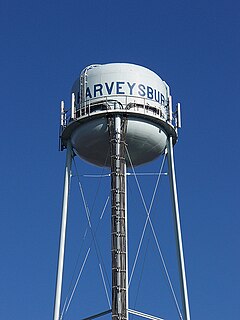 W
WPotable water diving is diving in a tank for potable water. This is usually done for inspection and cleaning tasks. A person who is trained to do this work may be described as a potable water diver. The risks to the diver associated with potable water diving are related to the access, confined spaces and outlets for the water. The risk of contamination of the water is managed by isolating the diver in a clean dry-suit and helmet or full-face mask which are decontaminated before the dive.
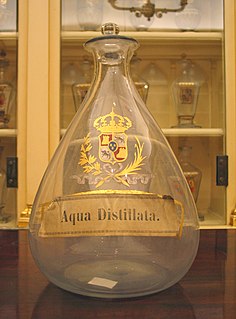 W
WPurified water is water that has been mechanically filtered or processed to remove impurities and make it suitable for use. Distilled water has been the most common form of purified water, but, in recent years, water is more frequently purified by other processes including capacitive deionization, reverse osmosis, carbon filtering, microfiltration, ultrafiltration, ultraviolet oxidation, or electrodeionization. Combinations of a number of these processes have come into use to produce ultrapure water of such high purity that its trace contaminants are measured in parts per billion (ppb) or parts per trillion (ppt).
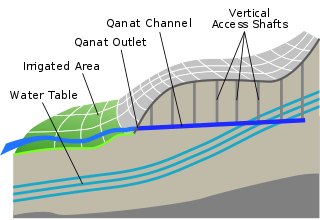 W
WA qanat or kariz is a gently sloping underground channel to transport water from an aquifer or water well to the surface for irrigation and drinking, acting as an underground aqueduct. Constructed in Iran, Iraq and numerous other societies, this is an ancient system of water supply from a deep well, that makes use of a series of vertical access shafts. The qanats still create a reliable supply of water for human settlements and irrigation in hot, arid, and semi-arid climates, but the value of this system is directly related to the quality, volume, and regularity of the water flow. Traditionally qanats have been built by hand labor in Arab-speaking areas by a group of skilled laborers, known as muqannīs. The profession historically paid well and was typically handed down from father to son.
 W
WRainwater harvesting (RWH) is the collection and storage of rain, rather than allowing it to run off. Rainwater is collected from a roof-like surface and redirected to a tank, cistern, deep pit, aquifer, or a reservoir with percolation. Dew and fog can also be collected with nets or other tools. Rainwater harvesting differs from stormwater harvesting as the runoff is collected from roofs, rather than creeks, drains, roads, or any other land surfaces. Its uses include watering gardens, livestock, irrigation, domestic use with proper treatment, and domestic heating. The harvested water can also be committed to longer-term storage or groundwater recharge.
 W
WReclaimed or recycled water is the process of converting wastewater into water that can be reused for other purposes. Reuse may include irrigation of gardens and agricultural fields or replenishing surface water and groundwater. Reused water may also be directed toward fulfilling certain needs in residences, businesses, and industry, and could even be treated to reach drinking water standards. This last option is called either "direct potable reuse" or "indirect potable" reuse, depending on the approach used.
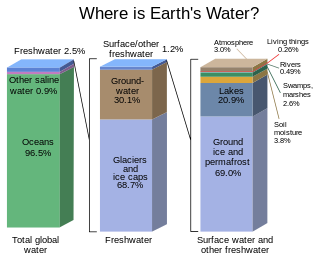 W
WWater resources are natural resources of water that are potentially useful. Uses of water include agricultural, industrial, household, recreational and environmental activities. All living things require water to grow and reproduce.
 W
WA rooftop water tower is a variant of a water tower, consisting of a water container placed on the roof of a tall building.
 W
WThe Roundabout PlayPump is a system that uses the energy created by children playing to operate a water pump. It is manufactured by the South African company Roundabout Outdoor. It operates in a similar way to a windmill-driven water pump.
 W
WSelf-supply of water and sanitation refers to an approach of incremental improvements to water and sanitation services, which are mainly financed by the user. People around the world have been using this approach over centuries to incrementally upgrade their water and sanitation services. The approach does not refer to a specific technology or type of water source or sanitation service although it does have to be feasible to use and construct at a low cost and mostly using tools locally available. The approach is rather about an incremental improvement of these services. It is a market-based approach and commonly does not involve product subsidies.
 W
WSolar water disinfection, in short SODIS, is a type of portable water purification that uses solar energy to make biologically-contaminated water safe to drink. Water contaminated with non-biological agents such as toxic chemicals or heavy metals require additional steps to make the water safe to drink.
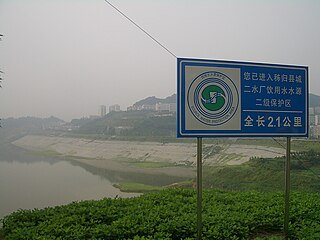 W
WSource Water Protection is a planning process conducted by local water utilities, as well as regional or national government agencies, to protect drinking water sources from overuse and contamination. The process includes identification of water sources, assessment of known and potential threats of contamination, notification of the public, and steps to eliminate the contamination. The process is applicable to lakes, rivers and groundwater (aquifers).
 W
WA standpipe is a freestanding pipe fitted with a tap which is installed outdoors to dispense water in areas which do not have a running water supply to the buildings.
 W
WA stock tank is used to provide drinking water for animals such as cattle or horses. Stock tanks can range in size from 100 L to over 5500 L and typically are made of galvanized steel. These tanks are filled either by a pump, windpump, creek, spring, or even rely on runoff water from rain or melting snow. In Texas, ranchers refer to ponds and watering holes as stock tanks.
 W
WStormwater harvesting or stormwater reuse is the collection, accumulation, treatment or purification, and storage of stormwater for its eventual reuse. While rainwater harvesting collects precipitation primarily from rooftops, stormwater harvesting deals with collection of runoff from creeks, gullies, ephemeral streams, and other ground conveyances. It can also include catchment areas from developed surfaces, such as roads or parking lots, or other urban environments such as parks, gardens and playing fields.
 W
WA treadle pump is a human-powered suction pump that sits on top of a well and is used for irrigation. It is designed to lift water from a depth of seven metres or less. The pumping is activated by stepping up and down on a treadle, which are levers, which drive pistons, creating cylinder suction that draws groundwater to the surface.
 W
WThe Turpan water system or Turfan water system in Turpan, located in the Turpan Depression, Xinjiang, China, is a vertical tunnel system adapted by the Turpan people. The word karez means "well" in the local Uyghur language. Turpan has the Turpan Water Museum dedicated to demonstrating its karez water system, as well as exhibiting other historical artifacts.
 W
WUtility sub-metering is a system that allows a landlord, property management firm, condominium association, homeowners association, or other multi-tenant property to bill tenants for individual measured utility usage. The approach makes use of individual water meters, gas meters, or electricity meters.
 W
WWASH is an acronym that stands for "water, sanitation and hygiene". Universal, affordable and sustainable access to WASH is a key public health issue within international development and is the focus of the first two targets of Sustainable Development Goal 6. Targets 6.1 and 6.2 aim at equitable and accessible water and sanitation for all. "Access to WASH" includes safe water, adequate sanitation and hygiene education. Improving access to WASH services can improve health, life expectancy, student learning, gender equality, and other important issues of international development. This can reduce illness and death, and also affect poverty reduction and socio-economic development. Challenges include providing services to urban slums, improper management of water distribution systems, failures of WASH systems over time, providing equitable access to drinking water supply and gender issues. WASH services have to be provided to household locations but also to schools, healthcare facilities, work places, markets, prisons, train stations, public locations etc.
 W
WThe Global Water Security and Sanitation Partnership (GWSP), formerly the Water and Sanitation Program, is a trust fund administered by the World Bank geared at improving the accessibility and infrastructure of water and sanitation for underdeveloped countries. GWSP works in more than 25 countries through regional offices in Africa, East and South Asia, Latin America, the Caribbean, and an office in Washington, D.C.. Heath P. Tarbert is the Acting Executive Director for the United States. The GWSP is best known for its work providing technical assistance, building partnerships and capacity building. GWSP focuses on both regulatory and structural changes and also behavior change projects, such as a scaling up handwashing project and scaling up sanitation project. Another key aspect of GWSP's work is sharing knowledge and best practices through multiple channels. The GWSP has determined five main focus areas: Sustainability, inclusion, institutions, financing, and resilience.
 W
WWater efficiency is reducing water wastage by measuring the amount of water required for a particular purpose and the amount of water used or delivered. Water efficiency differs from water conservation in that it focuses on reducing waste, not restricting use. Solutions for water efficiency focus not only on reducing the amount of potable water used, but also on reducing the use of non-potable water where appropriate. It also emphasises the influence consumers can have in water efficiency by making small behavioural changes to reduce water wastage and by choosing more water efficient products.
 W
WWater metering is the practice of measuring water use. Water meters measure the volume of water used by residential and commercial building units that are supplied with water by a public water supply system. They are also used to determine flow through a particular portion of the system.
 W
WWater pollution is the contamination of water bodies, usually as a result of human activities. Water bodies include for example lakes, rivers, oceans, aquifers and groundwater. Water pollution results when contaminants are introduced into the natural environment. For example, releasing inadequately treated wastewater into natural water bodies can lead to degradation of aquatic ecosystems. In turn, this can lead to public health problems for people living downstream. They may use the same polluted river water for drinking or bathing or irrigation. Water pollution is the leading worldwide cause of death and disease, e.g. due to water-borne diseases.
 W
WWater quality refers to the chemical, physical, and biological characteristics of water based on the standards of its usage. It is most frequently used by reference to a set of standards against which compliance, generally achieved through treatment of the water, can be assessed. The most common standards used to monitor and assess water quality convey the health of ecosystems, safety of human contact, and condition of drinking water. Water quality has a significant impact on water supply and oftentimes determines supply options.
 W
WWater resource policy encompasses the policy-making processes that affect the collection, preparation, use and disposal of water to support human uses and protect environmental quality. Water policy addresses provision, use, disposal and sustainability decisions. Provision includes identification, access, preparation for use and distribution. Uses include direct human consumption, agriculture, industry and ecosystem protection. Policy must set the rules for how water is allocated to the different uses. Disposal involves wastewater treatment and stormwater/flood management. Sustainability addresses issues such as aquifer depletion, reservoir management and mineral buildup.
 W
WTo enhance water quality monitoring in a drinking water network, water sampling stations are installed at various points along the network's route. These sampling stations are typically positioned at street level, where they connect to a local water main, and are designed as enclosed, secured boxes containing a small sink and spigot to aid in sample collection. Collected samples are analyzed for bacteria, chlorine levels, pH, inorganic and organic pollutants, turbidity, odor and many other water quality indicators.
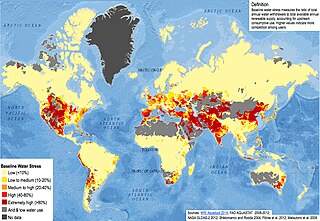 W
WWater scarcity is the lack of fresh water resources to meet the standard water demand. Humanity is facing a water crisis, due to unequal distribution resulting in some very wet and some very dry geographic locations, plus a sharp rise in global freshwater demand in recent decades driven by industry. Water scarcity can also be caused by droughts, lack of rainfall, or pollution. This was listed in 2019 by the World Economic Forum as one of the largest global risks in terms of potential impact over the next decade. It is manifested by partial or no satisfaction of expressed demand, economic competition for water quantity or quality, disputes between users, irreversible depletion of groundwater, and negative impacts on the environment. Two-thirds of the global population live under conditions of severe water scarcity at least 1 month of the year. Half a billion people in the world face severe water scarcity all year round. Half of the world's largest cities experience water scarcity.
 W
WA water stop or water station on a railroad is a place where steam trains stop to replenish water. The stopping of the train itself is also referred to as a "water stop". The term originates from the times of steam engines when large amounts of water were essential. Also known as wood and water stops or coal and water stops, since it was reasonable to replenish engines with fuel as well when adding water to the boiler.
 W
WThe water table is the upper surface of the zone of saturation. The zone of saturation is where the pores and fractures of the ground are saturated with water.
 W
WThere is no formal definition for the water-energy nexus – the concept refers to the relationship between the water used for energy production, including both electricity and sources of fuel such as oil and natural gas, and the energy consumed to extract, purify, deliver, heat/cool, treat and dispose of water sometimes referred to as the energy intensity (EI). The relationship is not truly a closed loop as the water used for energy production need not be the same water that is processed using that energy, but all forms of energy production require some input of water making the relationship inextricable.
 W
WA watering trough is a man-made or natural receptacle intended to provide drinking water to animals, livestock on farms or ranches or wild animals.
 W
WWine To Water is a non-profit organization committed to supporting life and dignity for all through the power of clean water. The organization was founded by Doc Hendley in 2007.